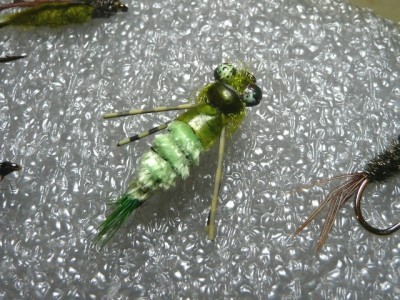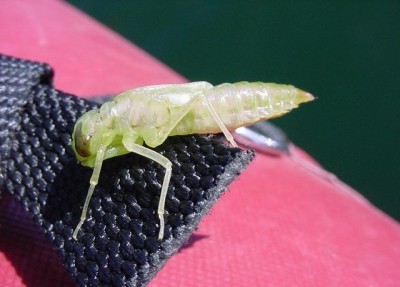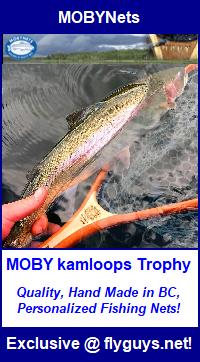Gord’s Molting Dragonfly Nymph …
Many moons ago when I was out tubing in Steward lake I saw my first molting dragonfly nymph.
I was just kicking off from shore after a pit stop when my flippers washed up what at first I thought was plastic or foam. Not because it was floating but because of the vivid colour. I flipped it up onto my tube apron and was a little freaked to see it was a dragon nymph. At first I thought it was an albino nymph but actually it was a watery pale minty colour.
It was later that I learned about the instars when the nymphs shed their skins as they grow bigger. It’s at this time, when the nymph has rid itself of the old skin, that it’s a bright green, growing darker as the new body hardens. The reason you rarely see them like this is they know they scream dinner to any prey in the area so they lie low. With dragons living up to four years before becoming adults they have many instars and don’t ever think that the trout aren’t aware of this!
Gord’s Molting Dragonfly Nymph Fly | Material List:
HOOK: Streamer/Wet nymph size 8 to 6
TAIL: Green deer hair
UNDERBODY: Foam 1/8″ thin strips
BODY: Mint green chenille
RIB: Gold
THORAX: Green dubbing
WING CASE: Green scud back
EYES: Plastic green/black chain bead
LEGS: Green black barred sililegs
Gord’s Molting Dragonfly Nymph Fly | Tying Instructions:
- Start by securing the eyes just back of the hook eye with enough room to wind your dubbing in front.
- Throw a pinch of green deer hair into a stacker, level the tips and tie in a tail – securing the remainder of the deer hair along the full length of the hook up to the eyes.
- Tie in foam (I have some craft foam that is see through thin and comes on a roll 2 inches wide I just cut long thin strips) and build a that big hip body.
- Tie in the chenille and gold rib then wind the chenille 3/4 of the way up the hook followed up with the rib wound in the opposite direction. (Lately I’ve been using Maxima Green 12 lbs for the rib)
- Tie in scud back just back of the eyes then pull forward out over the hook eye.
- Build a sparse dubbing loop with the green dubbing back at the end of the body and wind forward to and around the scudback building a head around the eyes & then wind it back to where you started.
- Pull the scudback over the thorax and secure at the end of the body with a few wraps.
- Tie in your sililegs on either side at the same spot and whip finish.
Sounds complicated but it’s really not.
Fish Gord’s Molting Dragonfly Nymph Fly Pattern near bottom and retrieve with a short, quick strips … oh and hold on tight! 😉
*** if you’re interested in custom tied, time tested & proven effective BC Interior fly patterns, but would rather buy than tie, please Contact us for details!
*** for more effective BC stillwater fly fishing patterns be sure to check out all of flies on our BCs best fly patterns index page!
Like our stuff? Subscribe by ![]() Feed or
Feed or ![]() Email
Email .jpg)












Hi. Great pattern. What time of year does molting happen?
Hey Rob,
Dragonfly nymphs (larvae) molt many times before reaching maturity … it’s the way they grow. Because they have an exoskeleton they can’t grow the way humans do so they do it by molting. Once they reach maturity they molt one final time and then emerge into an adult. So time frame for each molt would be specific to each particular insects growth rate. I believe the key for fly fishers is that they are vulnerable/more conspicuous while molting and therefore a good bet to imitate! Looking forward to hearing any others opinions on this too!
The legs look good but if you tie a knot in them it will give it more of a bend look, Im just saying but the fly looks good
Ollie
I realize this is an older post, but just came across it, and thought I would share. For the reasons, stated above, seeing these while fishing is indeed quite uncommon. In fact, until earlier this year, I had never seen a recently-molted nymph. I was at McQueen Lake with my class, doing pond studies when I saw dozens that looked like this. They were all around the dock at the overnight centre. It was at this point that I realized that since there are no fish in this lake, there was no reason for the dragons to hide their conspicuous colouring. I then started asking what other “secrets” a lake like this might reveal. Over the next 30 minutes, I was able to see specific movements and colours of mayfly nymphs, case-making caddis larvae, damsel nymphs, water boatmen, dragon nymphs, scuds etc. I realize these can be seen at many lakes, but without the fear of being gobbled at any minute, these creatures put themselves on full display. I learned more in this hour than I have over some entire seasons. If you get an opportunity, take some time to look in a fish-free lake. It was certainly worth it for me anyways.
Good idea Deesee, I never even considered it. Did you happen to take any pictures?